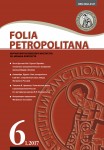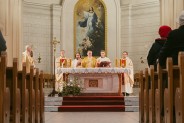Folia petropolitana 6 (1.2017)

Сборник материалов Шестых богословских чтений в память об о. Бернардо Антонини «1917–2017. Столетие под покровом Богородицы»
Содержание
«Политико-апокалиптическое» измерение явления Марии в Фатиме
Хосе Кристо-Рей Гарсия Паредес
Резюме:
Явление Пресвятой Девы Марии в Фатиме можно интерпретировать как «духовное» событие, которое произошло в историческом контексте ужасающего проявления зла: от Первой до Второй мировой войны вместе с их последствиями – смертью и деморализацией. Призывы Ангела и Богородицы говорили о Мире и увещевали вернуться к Завету. Они были словно «апокалиптическое» предостережение, предупреждавшее о риске настоящего времени и открывавшее перспективу надежды. Такая интерпретация Фатимской мариофании объясняет политическое и цементирующее влияние народного богородичного благочестия и открывает возможность плодотворной встречи политической теологии и мариологии.
Ключевые слова: мариология, политическое богословие, Фатима, явления Богородицы, апокалиптика.
Political-apocalyptic dimension of the appearance of the Virgin Mary in Fatima
José Cristo-Rey García Paredes
Abstract:
The appearance of the Blessed Virgin Mary in Fatima can be interpreted as a "spiritual" event that occurred in the historical context of a horrifying manifestation of evil: the First and Second World Wars, along with their consequences - death and demoralization. The Angel and the Virgin spoke of Peace and exhorted a return to the Covenant. They were literally "apocalyptic" warnings; they warned of the risks of the present time and opened prospective hope. Such an interpretation of the Fatima Mariophany explains the political and cementing influence of popular piety for the Blessed Virgin and opens the possibility of a fruitful meeting of political theology and Mariology.
Keywords: Mariology, political theology, Fatima, mariophanies, apocalyplic.
Свет, который есть Сам Бог: сокровенная связь между Фатимой и Россией
Алехандро Бургос
Резюме:
Статья – первая попытка подойти к Фатимским событиям с позиций Востока. В докладе говорится о том, насколько в Фатимском послании значимо и неизменно присутствие света как Самого Бога: «А мы увидели в огромном свете, который есть Бог…». Затем мы рассмотрим выражение «Свет от света» в Никео-константинопольском символе и у отцов-каппадокийцев, поговорим об опыте света у Симеона Нового Богослова, Григория Паламы, а также в диалоге Серафима Саровского с Мотовиловым. Отсюда последует вывод: как в греческой и русской традициях, так и в Фатимском послании мы находим онтологическое понимание света, который есть Бог. Именно это – внутренний, сокровенный центр, соединяющий Фатимское послание и русскую духовность.
Ключевые слова: Фатима, Богородица, нетварный свет, Симеон Новый Богослов, Григорий Палама, Серафим Саровский.
The light that is God: an intimate union of Fatima and Russia
Alejandro Burgos
Abstract:
This article is the first attempt to approach the Fatima apparitions from an Eastern point of view. It explains the significance and constancy of Light being present as God Himself. «And we saw an immense light that is God...» Then the focus shifts to the phrase "Light of Light" from the Nicene-Constantinopolitan Creed and the way the Cappadocian Fathers understood it. The article also considers the way the Light was experienced by Symeon the New Theologian and Gregory Palamas as well as how it is represented in a dialogue between Seraphim of Sarov and Nikolay Motovilov. The paper concludes: The ontological understanding of the “Light that is God” is found in both Greek and Russian traditions as well as in the Fatima message. This represents a common core that unites the Fatima apparitions with Russian spirituality.
Keywords: Fatima, Mother of God, Uncreated light, Symeon the New Theologian, Gregory Palamas, Seraphim of Sarov.
Религиозная жизнь в революционной России (по материалам архива В.Н. Бенешевича)
Татьяна В. Чумакова
Резюме:
В статье рассказывается о документах, хранящихся в личном фонде В.Н. Бенешевича в Санкт-Петербургском филиале Архива РАН. Бенешевич принимал активное участие в религиозной жизни страны первых послереволюционных лет. В 1917 г. был командирован в Тифлис по заданию Временного правительства в качестве Временно уполномоченного по делам Грузинской церкви. Участвовал в заседаниях Священного Собора Православной Российской церкви. Помимо документов, связанных с вопросом об автокефалии Грузинской церкви, в фонде хранятся документы, касающиеся приходской жизни в Петрограде, а также послереволюционный «самиздат»: машинописные копии переписки церковных деятелей и рассуждения о жизни церкви, одно из которых, возможно, принадлежит самому Бенешевичу. Анализ этих документов позволит дополнить наши представления о религиозной жизни Петрограда.
Ключевые слова: религиозная жизнь в России после 1917 г., православный приход, В.Н. Бенешевич.
Religious life in revolutionary Russia (based on the archival materials of V.N. Beneshevich)
Tatiana V. Chumakova
Abstract:
The article describes the documents stored in the personal fund of V.N. Beneshevich in the St. Petersburg branch of the Archive of the Russian Academy of Sciences. Beneshevich took an active part in the religious life of the country in the first post-revolutionary years. In 1917, he was sent to Tiflis on behalf of the Temporary Government as the Temporary Commissioner for the Georgian Church. He participated in meetings of the Holy Synod of the Russian Orthodox Church. In addition to the documents related to the issue of the autocephaly of the Georgian Church, the collection contains documents relating to parish life in Petrograd as well as the post-revolutionary “samizdat”: typewritten copies of the correspondence of church leaders and of arguments about the life of the church, one one correspondence being from Beneshevich himself. The analysis of these documents will allow us to amplify our understanding of the religious life of Petrograd.
Keywords: religious life in Russia after 1917, orthodox parish, V.N. Beneshevich.
Mater Verbi Dei: поиск иконографического изображения
Дариуш Пеляк
Резюме:
Богословские идеи и духовный опыт Церкви во все времена находили свое выражение в искусстве. Одним из главных церковных событии последних лет был синод, посвященный роли Слова Божия в жизни и миссии Церкви. В послесинодальном документе Verbum Domini папа Бенедикт XVI обращает внимание на Пресвятую Деву Марию, как на Ту, в Кем «достигнута совершенная взаимность Слова Божия и веры» (VD 27) и называет Марию Mater Verbi Dei. Этому наименованию Девы Марии и пути к созданию иконы с таким названием посвящена эта статья.
Ключевые слова: иконография, Богородица, Слово Божие.
Mater Verbi Dei: a search of iconographic expression
Dariusz Pielak
Abstract:
The theological ideas and spiritual experience of the Church has in all times found expression in art. One of the main Church events of recent years was the synod dedicated to the role of God's Word in the life and mission of the Church. In the Post-Synodal Apostolic Exhortation Verbum Domini, Pope Benedict XVI draws attention to the Blessed Virgin Mary as the one "in whom the interplay between the word of God and faith was brought to perfection" (VD 27), and he refers to Mary as Mater Verbi Dei. The article concerns this title of the Virgin Mary and the way of creating a so entitled icon.
Keywords: iconography, Mother of God, word of God.
